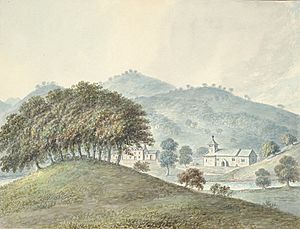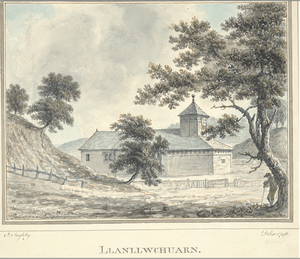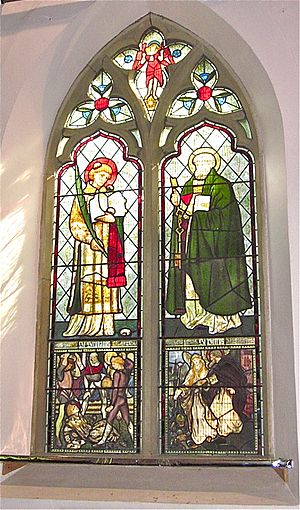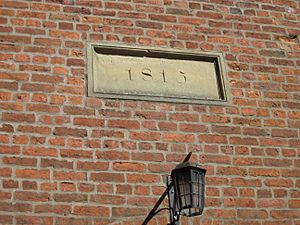St Llwchaiarn's Church, Llanllwchaiarn facts for kids
Quick facts for kids St Llwchaiarn’s church, Llanllwchaiarn |
|
|---|---|
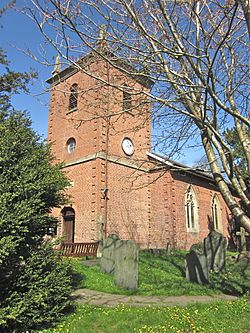
Llanllwchaiarn. Church from SE
|
|
| Lua error in Module:Location_map at line 420: attempt to index field 'wikibase' (a nil value). | |
| Location | Newtown with Llanllwchaiarn, Powys |
| Country | Wales |
| Denomination | Church in Wales |
| History | |
| Founder(s) | St Llwchaiarn |
| Dedication | St Llwchaiarn |
| Consecrated | Probably 7th century AD |
| Events | Rebuilt 1816 |
| Architecture | |
| Functional status | Active |
| Heritage designation | Grade II |
| Designated | 18 July 1949 |
| Architectural type | Church |
| Style | Georgian with Victorian interior |
| Construction cost | £1200 |
| Administration | |
| Parish | Llanllwchaiarn |
| Archdeaconry | Montgomery |
| Diocese | St Asaph |
St Llwchaiarn's Church is a special old church located in a place called Llanllwchaiarn. This area is now part of Newtown with Llanllwchaiarn in Powys, Wales. The church sits on a small hill, looking over the Severn River. It is just northeast of Newtown. The church building you see today was rebuilt in 1816. In 2011, a beautiful old carved screen was moved here. This screen was originally from St Mary's Church in Newtown.
Contents
Who Was Saint Llwchaiarn?
The church is named after Saint Llwchaiarn. He was a saint from the 6th century. He is also the patron saint of a nearby area called Llanmerewig. There are also two parishes in Ceredigion named after him. A poet from the 16th century, Siôn Ceri, wrote about amazing things Saint Llwchaiarn supposedly did. These stories include him fighting a dragon. He also made a deer jump into a pool of water. However, there is not much clear information about his real life.
How Old is the Church?
The churchyard, which is the land around the church, has been made bigger recently. But the original churchyard is a raised, almost round area. It has many very old yew trees. A church with a round churchyard and a very old dedication often means it was built a long, long time ago. This church was likely founded in the 6th or 7th centuries.
The church is mentioned in old records from 1254. It was called 'Ecc'a de Llanlocharen'. In 1263, part of the church was given to a nunnery at Llanllugan.
Pictures of the Old Church
In the 1790s, a writer named Thomas Pennant asked an artist, John Ingleby, to paint pictures. These paintings were for a new version of his book, Tour in Wales. The original paintings are now kept at the National Library of Wales.
In 1795, John Ingleby painted two pictures of Llanllwchaiarn Church. These are the only known pictures of the church before it was rebuilt in 1815. The old church had a special bell tower supported from the inside. One painting shows the church from the south, looking across the River Severn. The other shows it from the north.
Rebuilding the Church
The church you see today was built on the same spot in 1815. It cost £1,200 to build. It was a simple brick church in the Georgian style. It had a square tower. Later, in 1864, a chancel and vestry were added. The chancel is the part of the church near the altar. The vestry is a room for the clergy.
More work was done in 1865 by R.J. Withers. This included making the chancel longer and adding wooden bench seats. The old east wall of the church was opened up. A new arch made of yellow sandstone was built. This stonework was designed by Edward Jones from Newtown. The round windows were also changed to the Gothic style. Stained glass windows were put in, including one made by Morris & Co..
The Special Screen from Newtown
In 2011, a medieval carved screen was moved to Llanllwchaiarn church. This screen was made around 1500. It was originally from St Mary's Church in Newtown. An expert named Fenton thought it was "perhaps the most perfect thing of the kind in the kingdom." Another person, Rev John Parker, described it in 1829 as "a world of Gothic art." He said it had "the highest luxuries of workmanship and colouring."
The largest part of the screen that still exists has five sections on each side of a Tudor-style arched door. The carvings have circles, quatrefoils (four-leaf shapes), and wheels. The top beam, called a bressumer, has detailed patterns. These include leaves, flowers, vines, pomegranates, and seaweed. The carvings still have gold, red, and green colors. A part of the curved ceiling, called coving, is also saved. It has fancy panels and scrolling designs.
War Graves in the Churchyard
The churchyard is also the resting place for soldiers who died in wars. It contains the Commonwealth war graves of two soldiers from World War I. They were part of the Royal Welch Fusiliers. There is also a Warrant Officer from the Auxiliary Territorial Service who died in World War II.
Gallery


